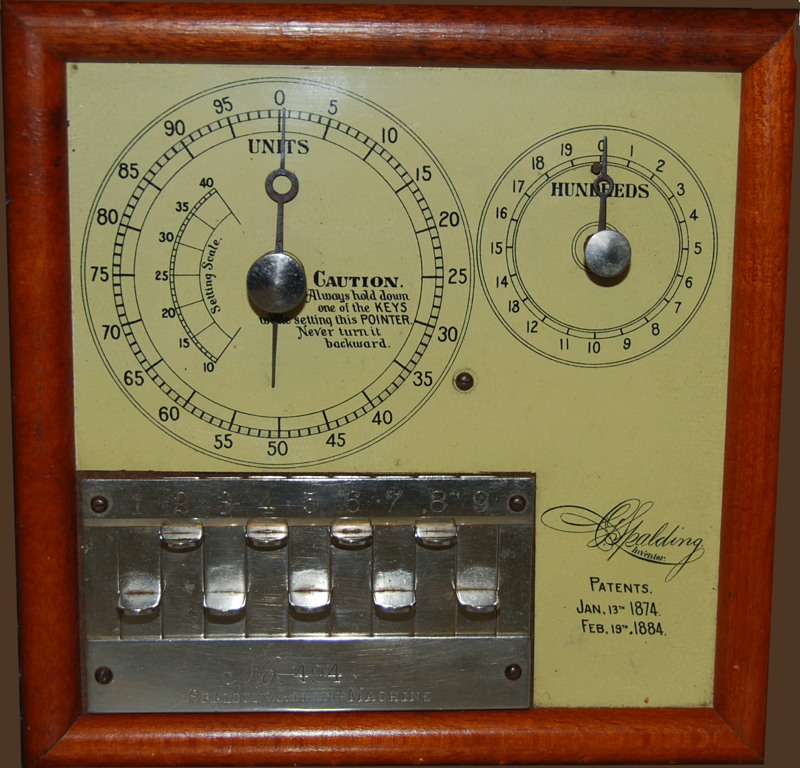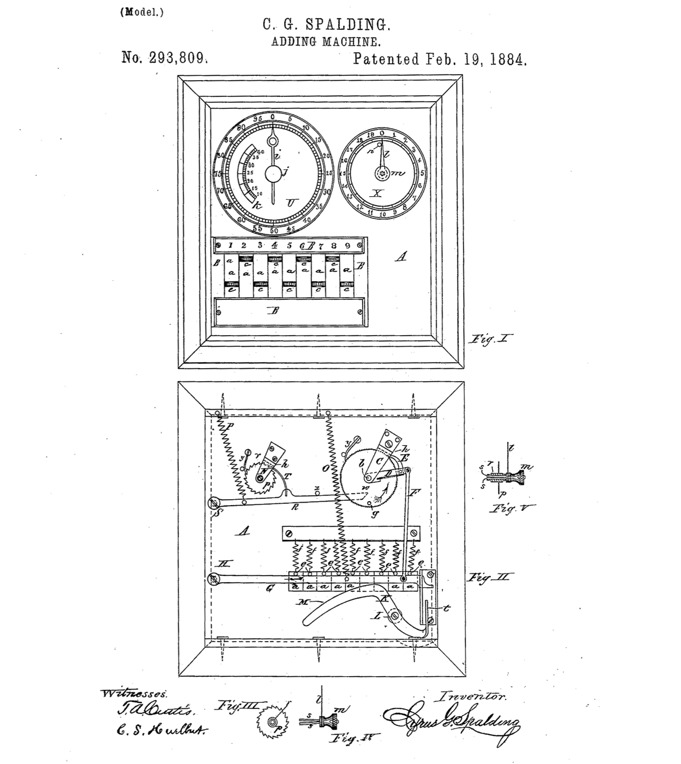
This rare adding machine is one of some 8 known to exist. According to Martin (pp 87–88, English edition) it was “never put into production and remains unknown in practice.” Nevertheless it is clear that several hundred were produced and sold. As Martin notes it is a “single-column adding machine with nine slides, situated in one row, for setting up the individual digits. Instead of the customary counting gears, this machine has mounted on its surface two numeral dials, each with a pointer. The large dial on the left is for the numbers 1 to 99; the hundred is automatically transferred to the smaller dial on the right.”
Provenance: ex “Dunottar Collection” of the late David Gamble, 2014.
Instructions for the Spalding Adding machine.
THE SURPRISE ADDER
THIS Machine has only 9 Keys, one for each numeral, making it easy to train the fingers of the LEFT hand to operate them correctly and rapidly, so that the operator can keep his eye constantly on the column he is adding, and move the keys as fast as his eye can catch the Figures. It also becomes possible to add mentally, and at the same time with the Machine, so proving the work at one operation.
INSTRUCTIONS Place the Machine at the left of the book or paper containing the figures, in such a position that the thumb may rest against lower edge of the frame, and the fingers be perfectly free to operate the keys.
Move keys 9 and 8 by the forefinger, 7 and 6 by the second, 5 and 4 by the third, and 3, 1 and 1 by the little finger. Push down one key at a time as far as it will slide, and allow it to return to its place. Avoid a sudden jerk downward or letting it snap from the finger.
In carrying, pull down the key corresponding to the unit of the sum to be carried and turn the pointer, by the thumbscrew, to the ten place on the dial. Thus, if 59 is the sum to carry, pull down key 9, and turn to 50. As the right hand, in turning the pointer, covers the figures from 1 to 40, on the dial, it may he guided by the setting-scale, mid short end of the pointer, for these numbers. If the sum to carry is a unit pull down the corresponding key, and turn to zero.
Last of all, turn back the Hundreds Pointer, which may be turned in either direction, at will. To set the Machine at zero, pull down key 5, and turn to 95. The units pointer must always be turned forward, and can beturned only when some key is pulled down.
Patents
The original invention was patented on 13 January 1874 as US Patent 146407. The improved design of this machine (which has the additional hundreds dial added) was patented as US Patent 283809 on 19 February 1884 and is shown below.

Known Surviving Spalding Calculators
| Serial | Provenance | Reference |
| 228 | ebay sold for $5,350 | Worthpoint |
| 351 | shown on Flickr | 1 |
| 392 | Goldman Collection | 2 |
| 414 | Oughtred Society Journal | vol 16, no. 2, 2007 |
| 443 | Brekker sold for 3689 Eu | 24 Nov 20073 |
| 494 | collection Calculant | this page |
| 723 | Museum of Business, History and Technology | 4 |
| ? | ebay sold 1 May 2011 for $3650 | Worthpoint |
1 https://www.flickr.com/photos/maxg/118709198/ (↑)
2 http://www.jmgoldman.com/index.php?page=spaldingp1.htm (↑)
3 Bulletin de Liaison de l’Association Nationale des Collectionneurs de Machines à Ecrire et à Calculer Mécanique, 30 March 2008, p. 11. (↑)
4 http://www.netdocent.com/objects/viewObject.aspx?id=353000A3-3BFF-40ED-B146-88C1AFBE7497&circa=1884 (↑)
Pages linked to this page
 This work by Jim Falk is licensed under a Creative Commons Attribution-NonCommercial-NoDerivs 3.0 Unported License Click on the logo to the left to see the terms on which you can use it.
This work by Jim Falk is licensed under a Creative Commons Attribution-NonCommercial-NoDerivs 3.0 Unported License Click on the logo to the left to see the terms on which you can use it.